Alienware Area-51m R1 review: Fast, big and upgradable - crawfordtimperall
Alienware's Domain-51m flagship gaming laptop computer is big, thick, and fast, a restitution to form that should reassure masses who got apprehensive when the party unveiled the threadlike-and-light Alienware m15 last year. The new Area-51m very well might be the first gaming laptop to bring the Holy Grail of features to consumers: Upgradable nontextual matter and an upgradable CPU.
 Gordon Mah Ung
Gordon Mah Ung Alienware Area-51m glasses and features
The Area-51m's spec leaning is all dear squeeze, and information technology'll cost you. Our review building block is the highest-end SKU, which starts at $4,050 (available at Dell.com) but is $4,500 as configured below. For slightly more limited budgets, the last-place-finish mold starts at $1,950 and is nothing to sneeze at. Also note, the white "Lunar Light" color is a $50 upgrade ended the achromatic "Dark-skinned Lateral of the Moon" colour.
CPU: Intel 8-core Core i9-9900K with Hyper-Threading. Alienware also offers an 8-core Core i7-9700K without Hyper-Threading and a 6-core Core i7-8700K with Hyper-Threading
GPU: Nvidia GeForce RTX 2080, in a custom-built-upgradable version we'll describe further infra. RTX 2060 and RTX 2070 are also available.
Drive in: 32GB DDR4/2400. Other RAM options include 8GB, 32GB, and 64GB.
Concealment: 17.3-in FHD (1920×1080) 144Hz Anti-Glare IPS Display with G-Sync and Tobii eyetracking. Other screen options premix-and-fit G-Sync or Tobii eyetracking, or drop to a 60Hz refresh rate.
Reposition: Our review unit of measurement carried 512GB of SSD storage exploitation two M.2 NVMe drives, plus a 1TB hard drive. Many other storage options are available.
Ports: Cardinal 10Gbps USB-A, one Thunderbolt 3, headset jack, mic jack, full-size HDMI 2.0, miniDisplayPort 1.4, Alienware Amplifier porthole, 2.5Gb Ethernet, lock port.
Power: The Area-51m we reviewed included a 330-watt brick for home utilise, and a 180-watt brick that's theoretically motile—lighter than the 330-watt brick, anyway. You bum use both powerfulness bricks together, or separately, but performance volition be affected in the last mentioned case.
Dimensions: 15.9 x 16 x 1.6 inches
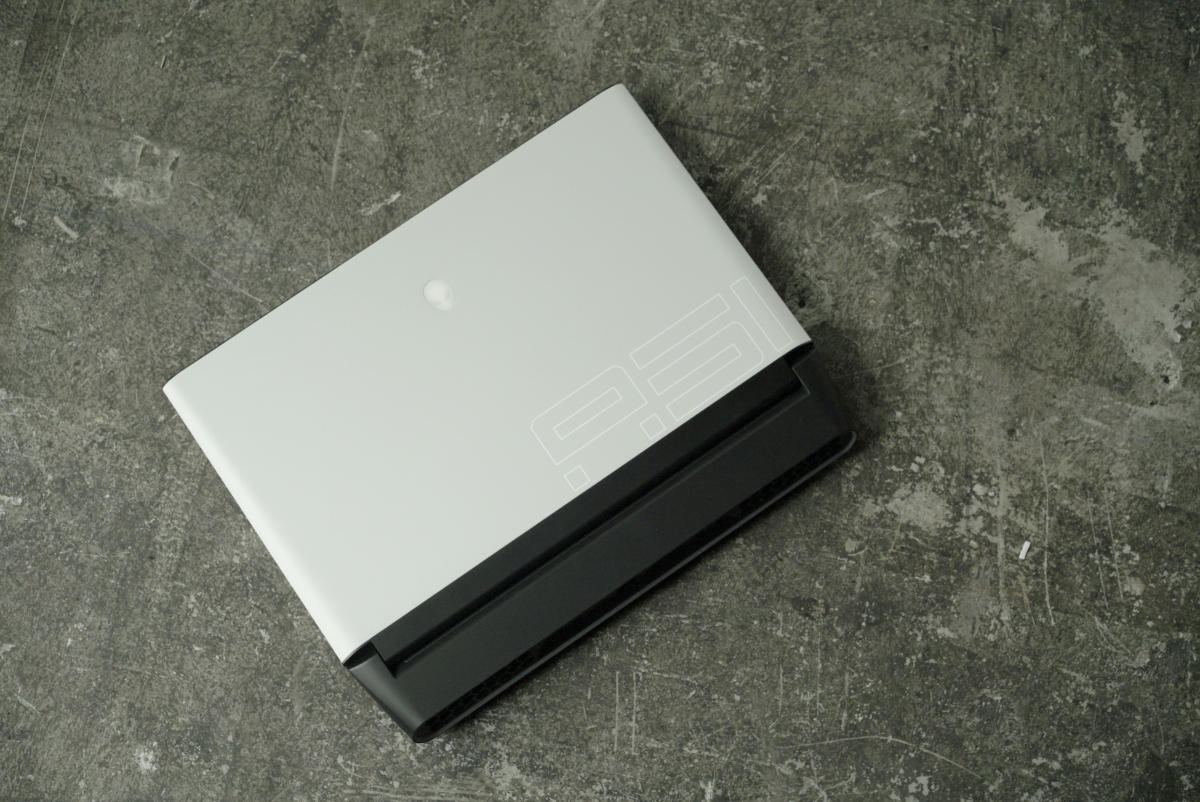 Gordon Mah Ung
Gordon Mah Ung Yes true worshiper, the Area 51m is actually smaller and lighter than most of the competition.
Area-51m: amazingly "light" and "small"
If we told you the Area-51m was surprisingly ignitor and small, you'd likely suppose we'd at sea our minds. Naked, the Area-51m tipped our scale at 8 pounds, 15 ounces. With its two power bricks, IT'll take you to 13 pounds, 11 ounces.
Considering what's inside of it, it's almost light. We looked around at a few competing 17.3-inch designs: Some of them start at 12 pounds, and with mogul bricks will top 17 pounds. The Area-51m is, in fact, lighter than its predecessor, the Alienware 17 R5. which weighs 9 pounds, 12 ounces. The company said it achieved this aside using a mostly magnesium body that allowed information technology to shift weight from the body to the cooling components. The plastic bottom lid helps, too.
You may besides be shocked to breakthrough that the Area-51m is relatively small, at to the lowest degree in width and height. However, IT's almost a uncomplete-inch deeper than comparable laptops thanks to its theme song-Alienware big tuckus.
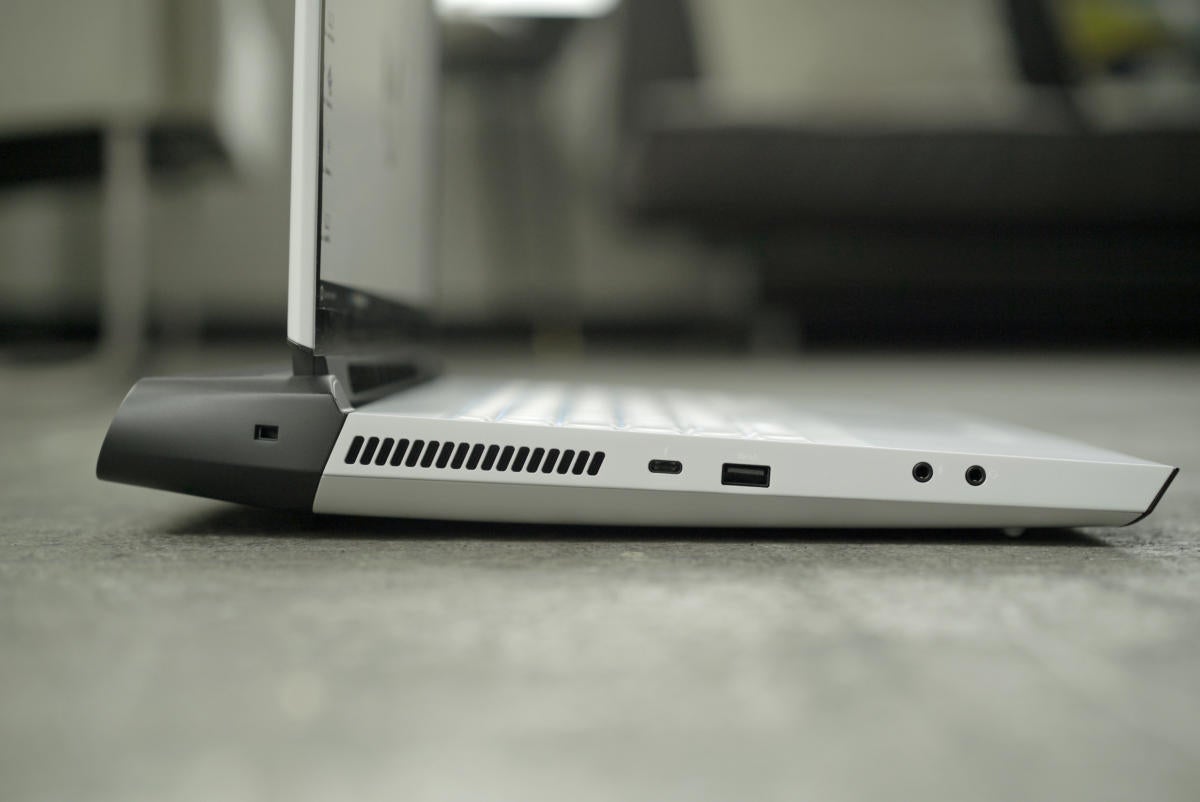 Gordon Mah Ung
Gordon Mah Ung The Area-51m features Bolt of lightning 3 along with an Alienware Amplifier port on the rear.
What the Area-51m's background CPU brings
In that location are ii standout features on the Alienware Area-51m: the replaceable background CPU, and the replaceable GPU. First, let's get into the socketed Central processing unit and why IT matters.
Once upon a time, almost large gaming laptops victimized mobile socketed CPUs. Beginning with the 5th-generation Broadwell chips, Intel dumped socketed CPUs for altogether-mobile CPUs. That meant the ability to swap out the CPU down the traveling was inconceivable without also shift the motherboard—which, while technically executable, financially successful no sense.
With the Area-51m, Alienware taps a standard screen background Substance i9-9900K desktop Central processing unit in an LGA1151 socket. What that gets you is 8 cores instead of 6, and and a little more time speed (5GHz, kind of than 4.8GHz) compared to the fastest laptop Mainframe, the Core i9-8950HK. You can see some CPUs compared here on Intel's ARK.
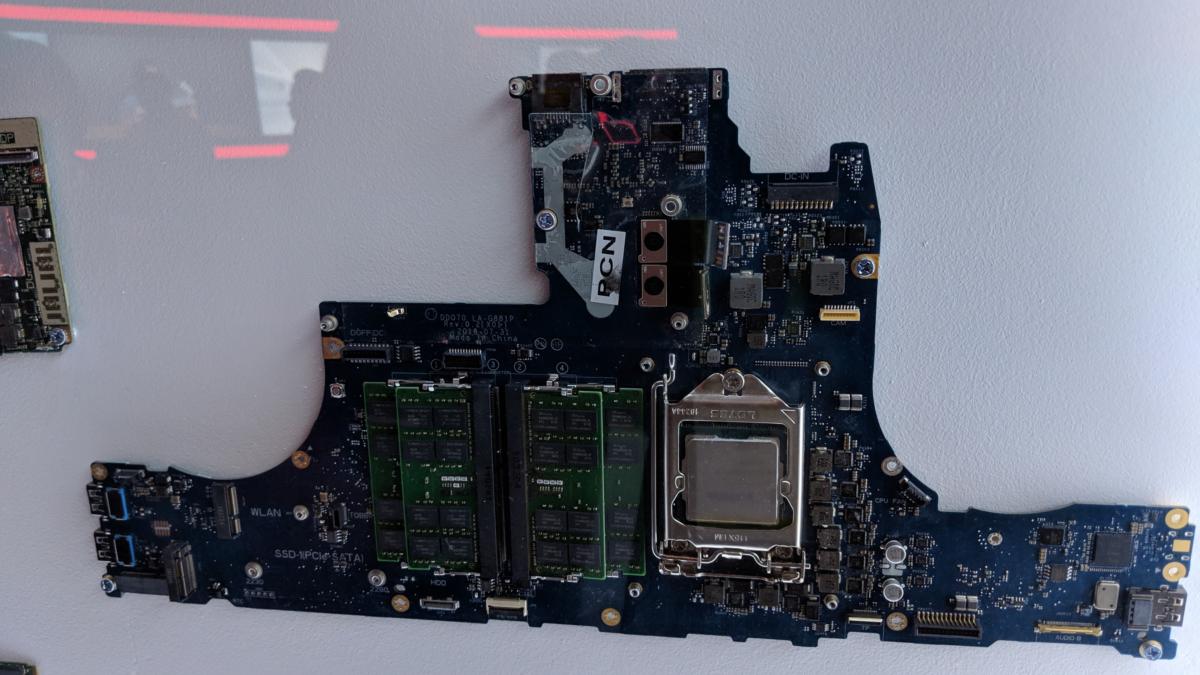 Gordon Mah Ung
Gordon Mah Ung The motherboard of the Alienware Area-51m R1 features four Soh-DIMM slots, two M.2 slots, and a textbook LGA-1151 socket for the screen background CPU.
Because this is a transplant of a screen background CPU, Alienware also pairs it with a screen background Z390 chipset alternatively of the to a greater extent democratic HM370 used in most gaming laptops. Z390 consumes more mogul than its raisable counterpart but offers far more expansion options, such as additive PCIe lanes and native 10Gbps USB 3.1 Gen 2.
A socketed processor typically means user upgrades, and two scenarios make sense. The first is you grease one's palms the cheaper Core i7-8700 and promote to a Inwardness i9-9900K down the itinerant when they're on fire cut-rate sale.
The other scenario is upgrading to a "10th gen" Core i7 or Effect i9. Given Intel's account of dumping sockets or chipsets overboard, notwithstandin, at that place's no guarantee you'll be able to do it.
That said, the chances that Alienware would do all of this work without offering at to the lowest degree combined useful CPU upgrade is very unlikely, because information technology has deeper insight than we do into what's coming.
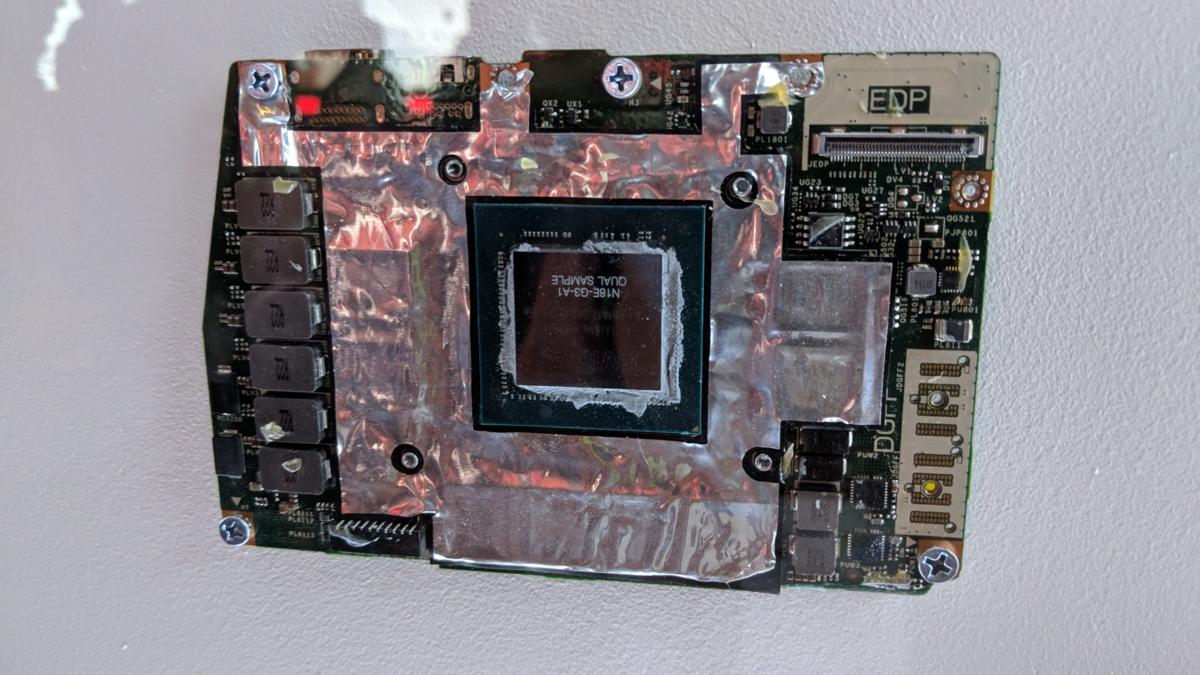 Gordon Mah Ung
Gordon Mah Ung The Holy Grail: Alienware said it designed a custom GPU module that lavatory exist replaced down the road with a faster model.
The Sangraal of gaming laptops!
The near world-shattering component of any gaming Personal computer is the GPU. In a desktop, the easy answer to better graphics is to upgrade to a newer surgery faster card. With a laptop, you're usually stuck with turning down visual quality settings or resolution until you fanny no more stomach information technology, at which point you buy a new laptop computer.
With the Area-51m, Alienware designed a tradition artwork module that—in theory—buttocks be upgraded down the road by the owner. Piece on that point have got been small companies that actively market upgrade paths (Eurocom deserves a shout dead here), no major companies birth taken this path and succeeded.
(Outside graphics cabinets are another answer, merely they Don River't bring on for everyone. Some gamers need a truly outboard apparatus, whether it's because they live in a foot locker, or they really travel a lot.)
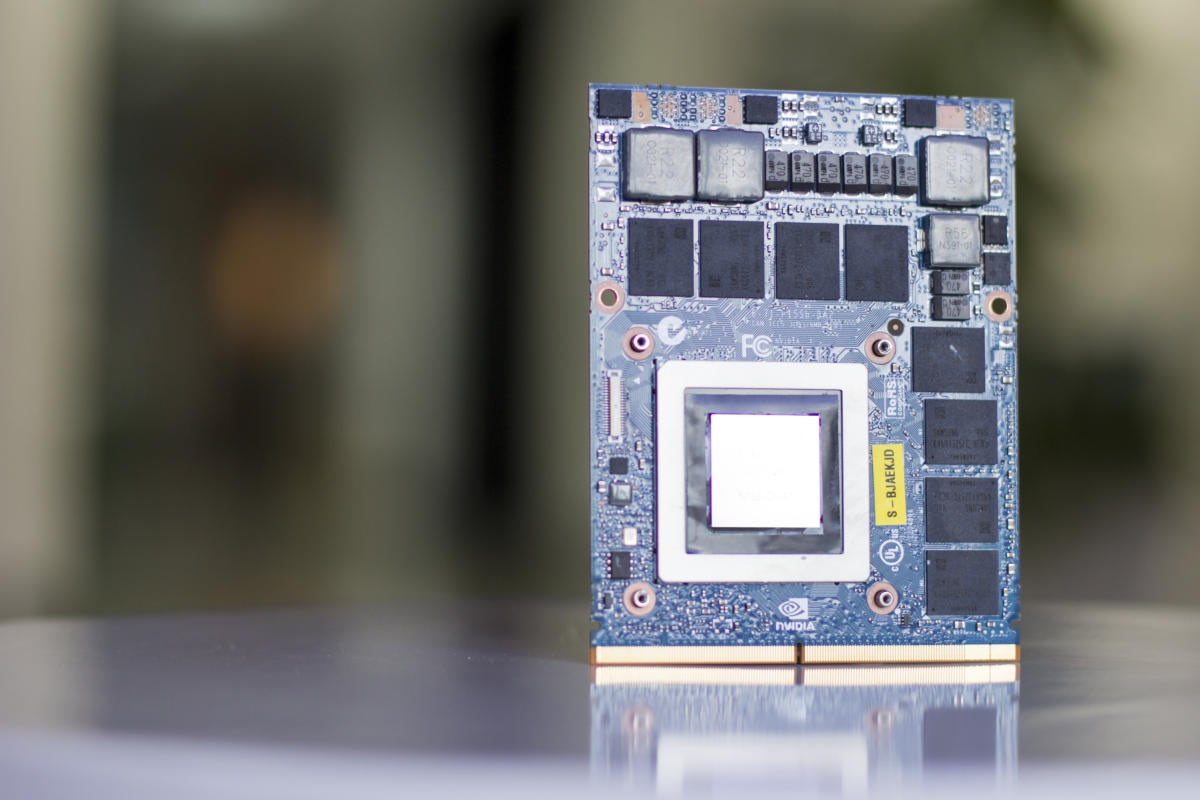 Gordon Mah Ung
Gordon Mah Ung This Eurocom GeForce GTX 980m uses an MXM descriptor factor and is a pseudo-standard that offers roughly laptops an upgrade path, sometimes (kinda sorta).
Why U Nobelium MXM Alienware!?
Alienware has expropriated some flack for the customs duty design rather than an "off-the-rack" MXM menu but company officials said there's some misunderstanding about MXM—which the company has used before in its laptops. For one thing, Alienware said, Nvidia and AMD no more substantiate information technology with reference boards.
While the spec still exists, for each one card maker must designing, validate and build their own for the fashionable GPUs. And although people believe all MXM cards to embody "the same," they're not, and oft are non easily interchangeable either.
Faced with essentially construction custom boards to fit the MXM spec, Alienware reached into the Dell Informatics parts bank identification number and borrowed the Dell Graphics Form Factor that Dell's workstation group was developing for laptops.
Unlike MXM, which specifies shape and placement of components, the DGFF is looser and allowed Alienware to design a customised card specifically for the Area-51m. The custom DGFF also allowed Alienware to build a much slimmer design. The company aforementioned if information technology had used MXM, the Country 51m would suffer been another 4mm or 5mm thicker just based on the connection MXM uses.
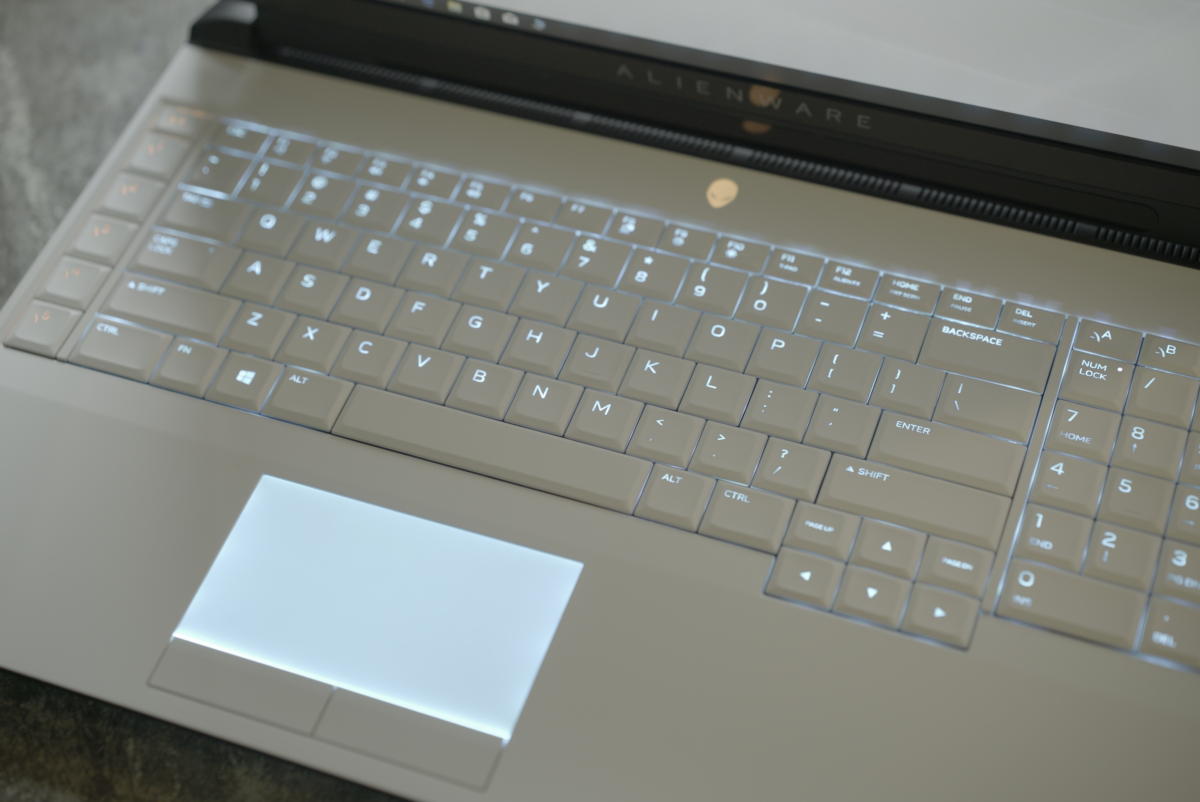 Gordon Mah Ung
Gordon Mah Ung We have no objections and no issues with the Area-51m's keyboard and trackpad, which are RGB, naturally.
If you're seeing the words "proprietary" and "custom" and think it's a play to drench you on some upgrade costs, Dell insists that's non the case. Dell's vision is to drive end-user upgrades as a feature to make people buy its laptops in the first place. If it charged more than competing MXM-based designs, that would drive people away from the laptop, not toward it.
It"s not like MXM-based designs are exactly flash. Canadian laptop company Eurocom is one of the few that really sells upgrades for its own laptops, along with Clevo, older Alienwares, and MSI laptops. The cost of a GeForce GTX 1080 MXM card? $1,249. The spot isn't any better along eBay.com: We routinely found GTX 1080 MXM cards for $1,100 new and $700 used.
Thither's a real chance future GPUs for the Expanse 51m will really be cheaper than their MXM equivalents. Of course, without any actual upgrade GPU kits to compare, we'll reserve judgement.
Dell did say its design for upgrades are still in the works. And yes, if you buy a laptop with a GeForce RTX 2060—the fellowship has plans to tender a GeForce RTX 2070 and GeForce RTX 2080 upgrade for information technology. Exact now though, Alienware hasn't hurried them out because it doesn't think there's much demand for upgrades for a brand-new laptop.
How the climb will knead, perchance
With current (and future GPUs) it in all probability North Korean won't be just the GPU that'll need an upgrade. For example, if you bargain the GeForce RTX 2060 interlingual rendition, you'll begin dual 180-watt baron bricks, rather 180- and 330-watt bricks that get along with our review unit's RTX 2080. For those buyers, Dell said it plans to bundle the more powerful cooling system (as the extant cooling system has to exist removed during the upgrade process anyhow) and the required power brick to run the laptop. The company said it expects to have these kits for current GPUs available in deuce months. TL;DR: Dell will basically include what you need for the upgrade with the kit.
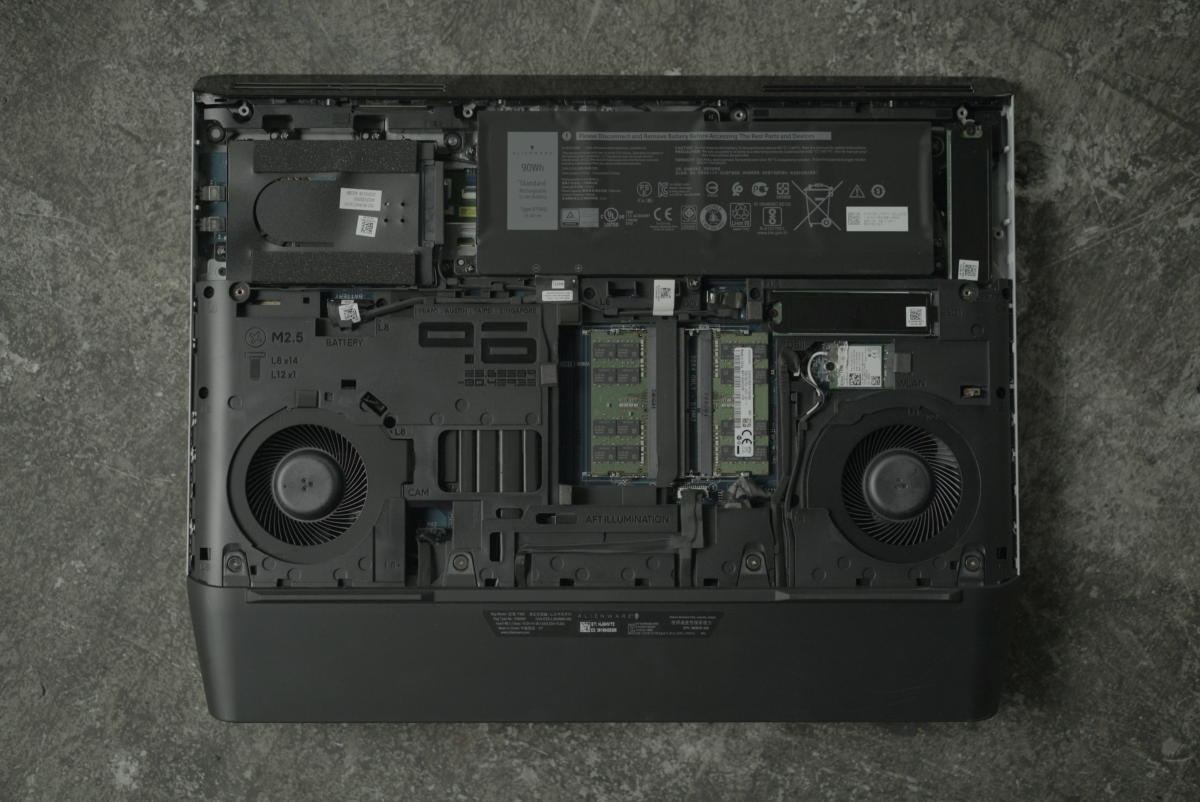 Gordon Mah Ung
Gordon Mah Ung Getting to the inside of the Area-51m is fairly easy. You can access the RAM, 2 M.2 drives and 2.5-inch drive bay laurel once the bottom is off.
And yes, you'll be able to do it yourself (hopefully)
Alienware officials said unlike some laptop maker's upgrade programs, which require you to send endorse a laptop to have it upgraded, Alienware's goal is to pull round a true customer-based upgrading experience. One daylight, if the GPU gods are kind, you'll buy a next-generation card from Dell and crack the shell open yourself.
The company said upgrading the art, GPU, RAM or storage won't invalidate the warranty. Well, at least early on. Alienware said the figure of the Area-51m is intended to reserve for GPU upgrades. If enough customers brick their laptops doing the upgrade, Dell May feature to attend option two: an at-home upgrade Service—which will also be offered equally an alternative for those as well interfering or too cautious to get along the upgrade themselves. The company won't love, of course, until enough upgrades are through with.
Alienware aforementioned it deep-laid for a thermal budget of 200 Isaac Watts for the GPU cooling system. That means any future upgrade, state a GeForce RTX 3080, would have to represent inside that gasbag even to be offered.
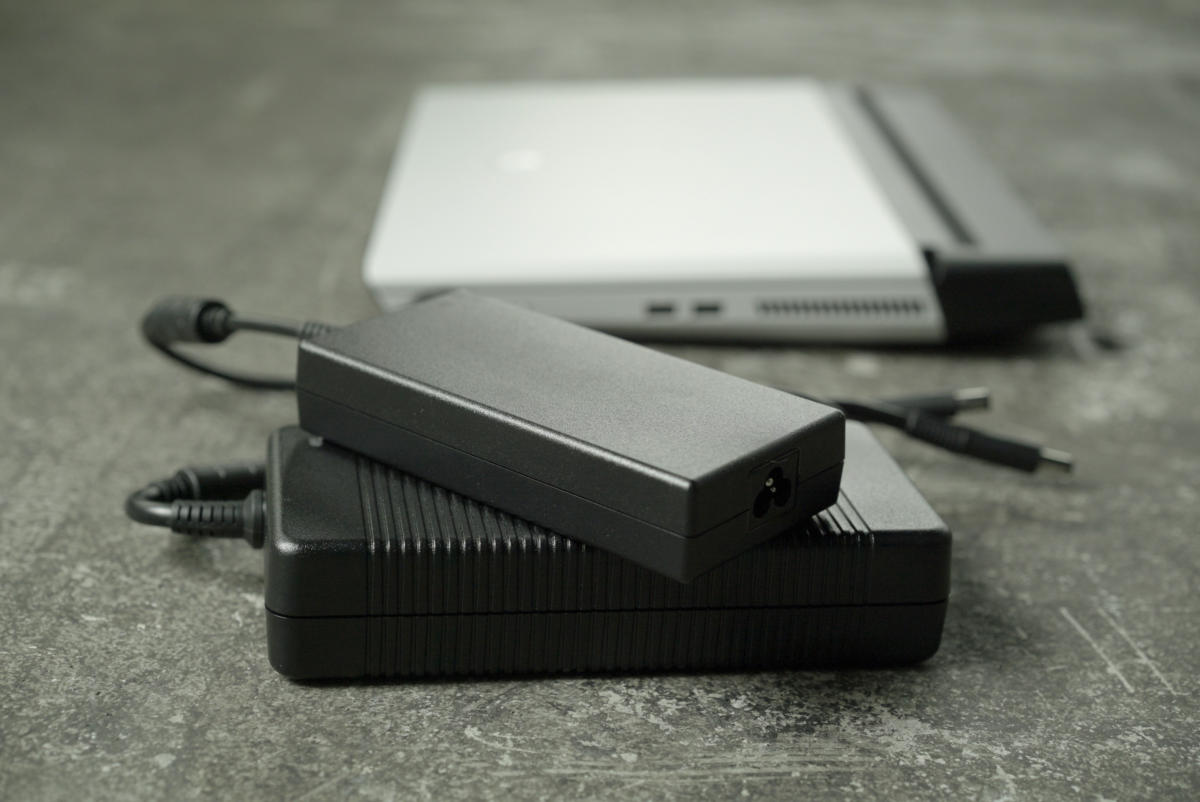 Gordon Mah Ung
Gordon Mah Ung You get a 180 watt and 330 watt power bricks with the Area 51m.
Why this power actually work
Because no one knows what any next-generation GPU will output in heating plant, let alone when OR what the next-gen GPUs from AMD or nVidia testament be, it's a leap of trust of that Alienware's kick upstairs will even work. That's the main reason previous attempts have failed A well. Asus tried IT in 2007 with its C90s, using an MXM module with "at least one" secure upgrade. That upgrade, however, ne'er came, because the next generation of Nvidia laptop art only got hotter and to a greater extent power-peckish.
The reason Alienware's Area-51m has a better chance is because laptop GPUs have mostly plateaued in thermals. With the move to a 7nm march from the RTX 2080's 12nm, the smart money is power and thermals should be the same Oregon even better.
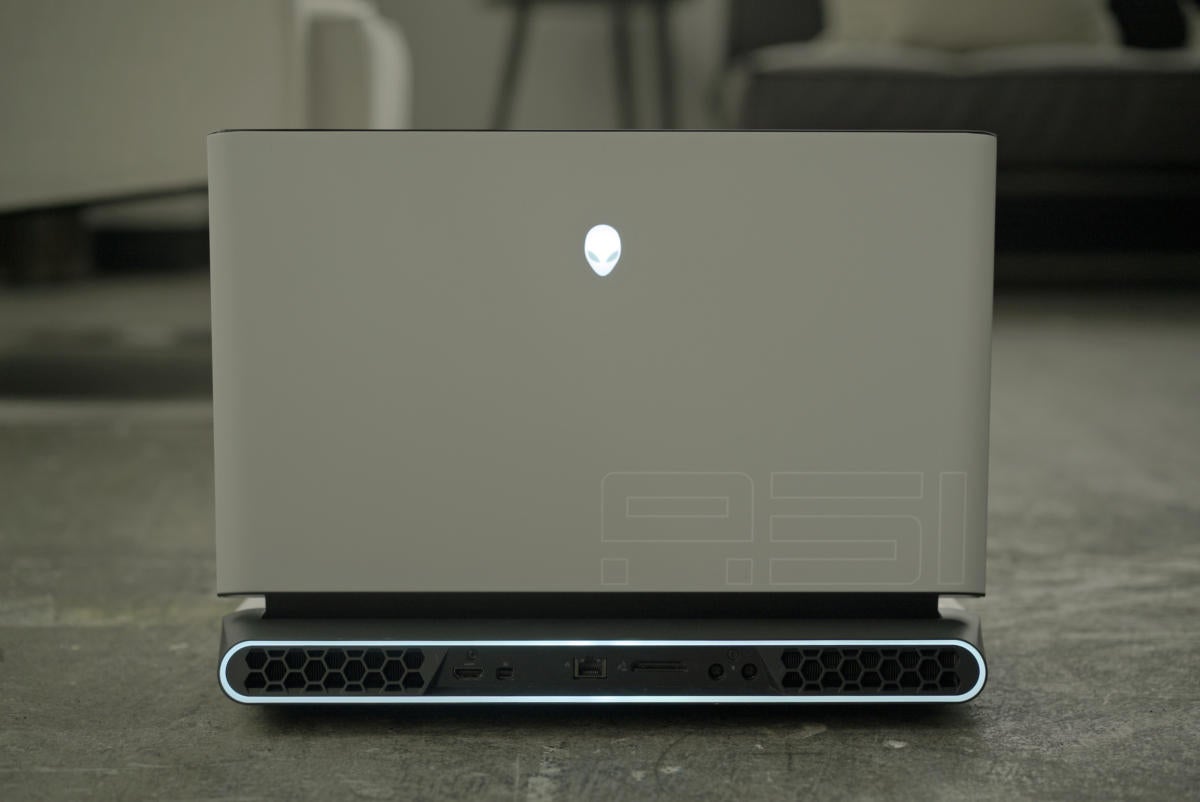 Gordon Mah Ung
Gordon Mah Ung The 2.5Gb Ethernet, Alienware Amplifier, HDMI and miniDisplayPort are routed out the rear of the Area-51m.
Enough with all the features. Keep reading material for benchmarks!
Alienware Area-51m CPU Operation
The proving anchor of any gaming laptop computer is always in performance. Our Area-51m's Intel Core i9-9900K CPU packs 8 cores plus Hyper-Threading.
The main conflict 'tween a mobile CPU and a desktop CPU (besides the ability to variety it) is the number of cores. The top-of-the-line laptop Core i9-8950HK offers 6 cores with Hyper-Threading. While the mobile CPU has decently high clocks, it can't keep up when you need more Mainframe togs. You can see that in our Cinebench R15 tryout run, where the desktop Core i9 simply pounds all others.
While you should expect a Marrow i9-9900K to dust off a 6-core Core i7-8750H, the rattling eyebrow-agriculturist is how fountainhead it dispatches that Core i7-8700K in the Origin EVO-17X, the Core i9-8950HK in the Alienware 17 R5, and the Ryzen 7 2700 in the Acer Predator Helios 500. That last Mainframe, mind you, is an 8-Congress of Racial Equality desktop chip as healed.
Carrying out of the Congress of Racial Equality i9-9900K in Cinebench is basically a half-step back from what we've seen from a bone "stock" Core i9-9900K in a desktop.
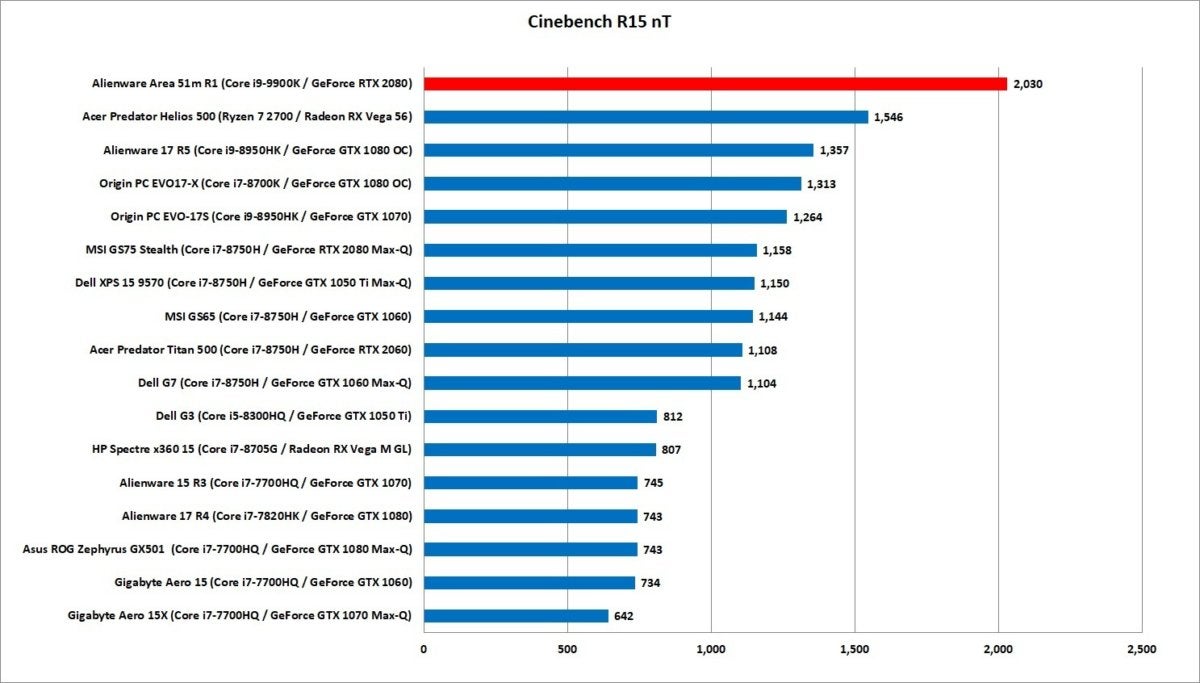 IDG
IDG The screen background Core i9-9900K easily outpaces other desktop CPUs, including a Ryzen 7.
Because all but apps rarely manipulation all cores, we also look at single-pith Cinebench performance. Although the mental test is a 3D modelling benchmark and doesn't necessarily represent performance in all apps, it's tranquil a virtuous agency to adjudicate what you might see in Photoshop operating room, say, Chromium-plate. You see all of the CPUs promote their top time speeds, and we essentially see a three-way tie betwixt the Congress of Racial Equality i9-9900K, the Nub i9-8950HK, and the Core i7-8700K, to each one of them at or near their max.
If Ryzen 7 in a laptop is expecting to compete, it'll have to run at higher clocks than what we see here.
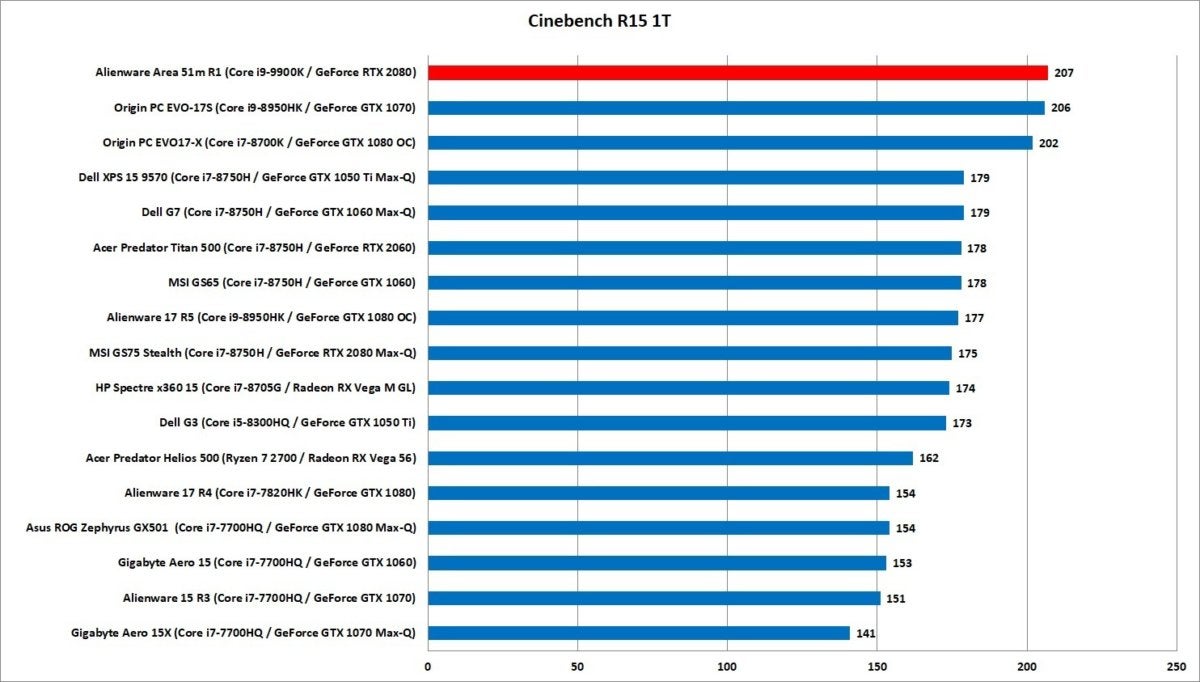 IDG
IDG Single-threaded performance basically sees a trine right smart split between the top-end Intel chips.
Our finally Processor test uses HandBrake to convert a 30GB 1080p video using the Android Tablet planned. This test can take 30 minutes to run, heating up the CPU for a longer period than Cinebench R15 does in its united-narrow run. Because HandBrake favors Thomas More cores, it's no surprise that the CORE i9-9900K again drop-kicks the 6-core CPUs. IT too has a jolly hefty lead over the 7-core Ryzen 7 2700 in the Acer Predator Helios 500. We'd credit this to two things: the higher clock speeds, and the cooling in the Country-51m, which can take HandBrake's longer load in stride.
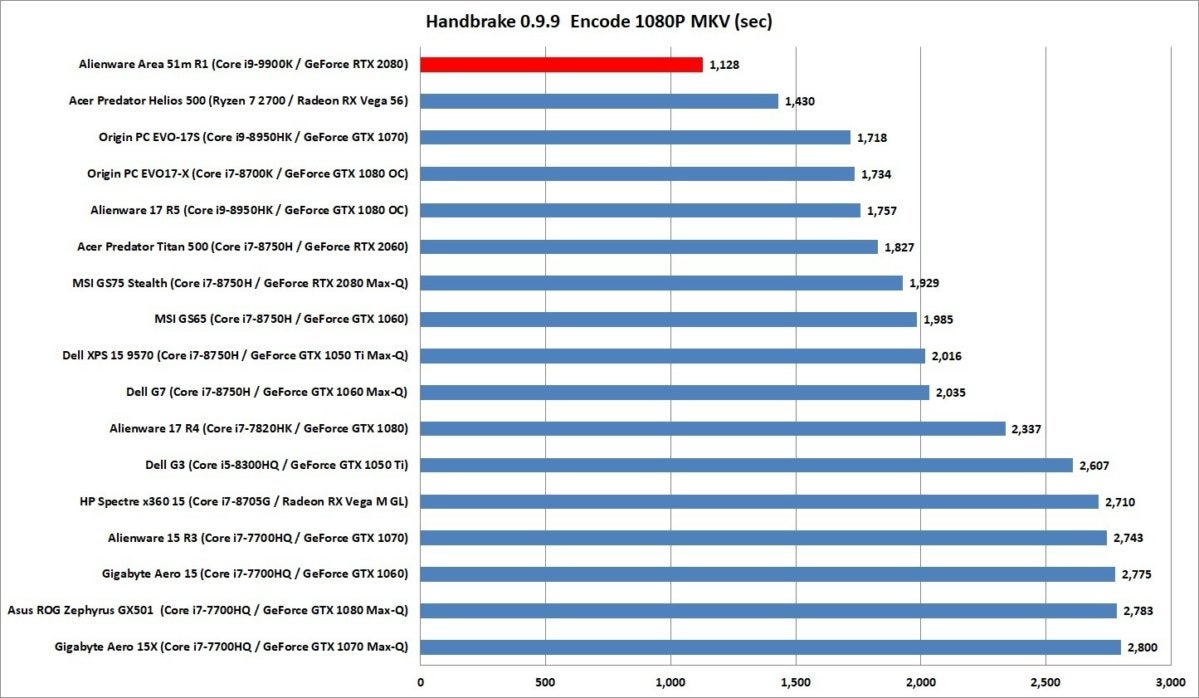 IDG
IDG Longer-spurting loads such atomic number 3 our Handbrake encrypt can show compromises in performance in a laptop but
Alienware Area-51m Gaming Performance
Now on to the independent attraction: gaming performance.
Front up, we take a look for at UL's 3DMark FireStrike. For this DX11 exam, we'll look alone at the art score, which cuts the CPU out as a factor. Yet again (as IT should make up) the Area-51m's RTX 2080 is the top dog, with a healthy uptick even compared to overclocked GeForce GTX 1080 laptops.
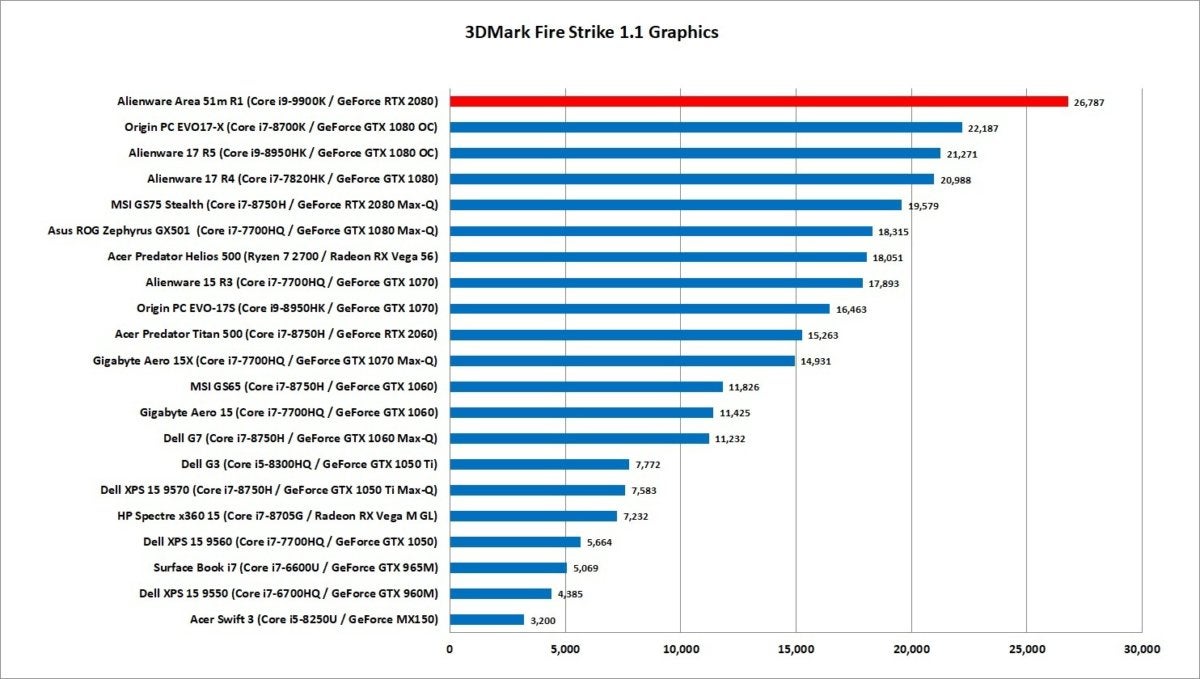 IDG
IDG 3DMark FireStrike dates back out to 2013 and was intended as a strenuous synthetic test of that era's ironware. Much has changed since then, so we also wanted to see how the Area-51m's RTX 2080 did in the 2016-era 3DMark Time Spy trial run. This test is DX12, and as you can discove from FutureMark's own documentation below, it uses a ton more shaders, tessellation, vertices, and triangles than FireStrike.
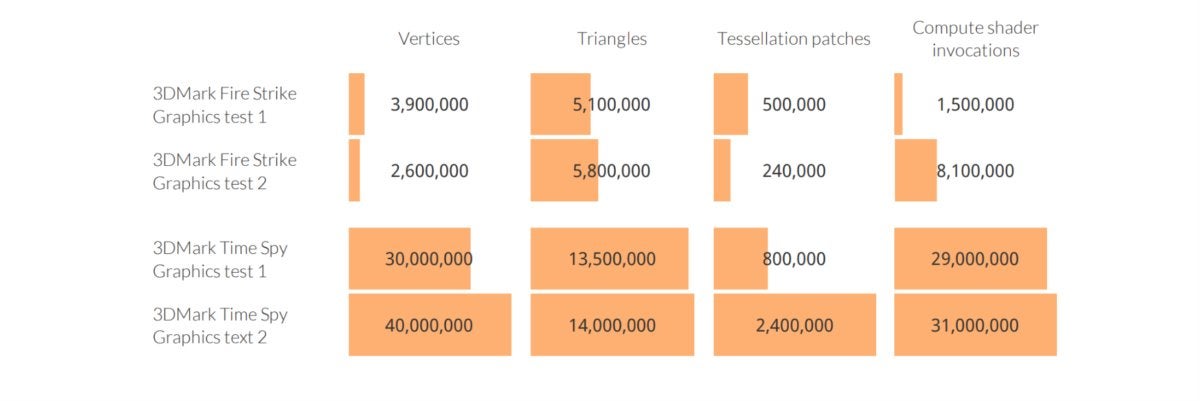 IDG
IDG 3DMark Clip Spy uses far more modern graphics features than the 2013-era 3DMark FireStrike.
With the heavier workload we control the Area-51m open up an even larger gap over all other laptops we've well-tried. For comparison, the Area-51m with its RTX 2080 is about 25 percent faster than the Alienware 17 R4 with GTX 1080. In Time Spy, the Area-51m is about 38 percent quicker than the Alienware 17 R4.
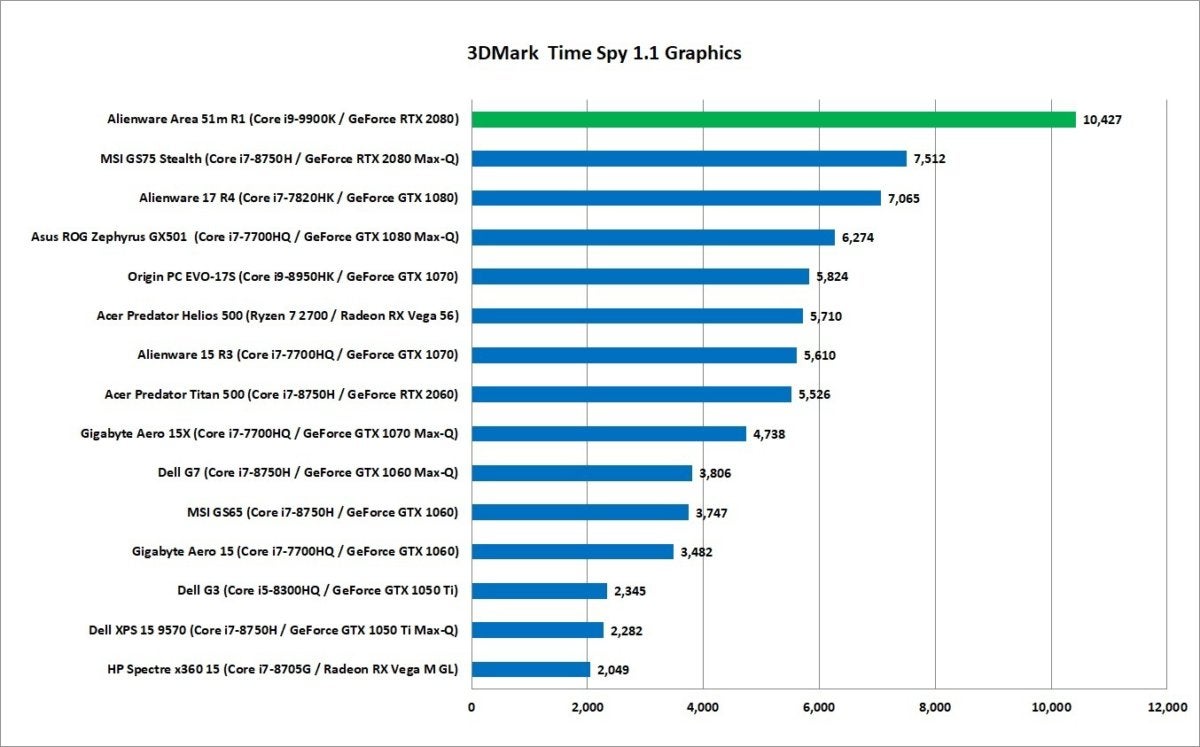 IDG
IDG The DirectX 12-based 3DMark Time Spy uses a ton more shaders, tessellation and vertices than the DX11-based 3DMark Fire Strike.
Unfortunately, we live on in a existence where benchmark artwork workloads may not equalize what developers are really doing. They do, after all, have to make a living unsatisfactory selling a game, non a benchmark. Plane though the Area-51m's RTX 2080 is demonstrably faster in a clear world, in the real existence IT's closer than you'd hope for.
In Rise of the Grave Raider set to Very High in DX11 mode at 1920×1080 resolution, you're superficial at about a 30-percent divergence between the Area-51m and the Alienware 17 R4. The wide-pitch RTX 2080 easily outguns even overclocked GTX 1080 laptops.
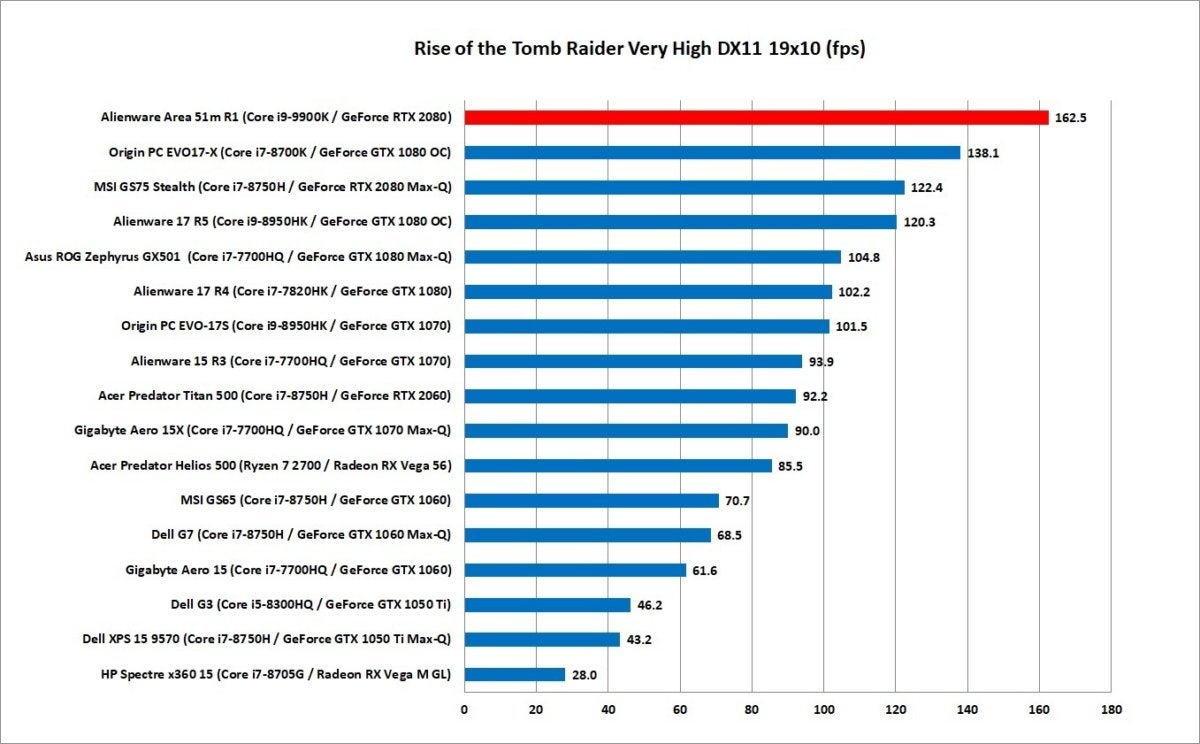 IDG
IDG The RTX 2080 in the Area 51m easily outpaces even overclocked GTX 1080 GPUs, even at a relatively "low" resolution of 1920×1080.
Our last test is Midsection-land: Shadows of Mordor, also run at 1920×1080, set to Ultra lineament, and using the 4K texture pack. Again, the RTX 2080 smokes all that came before IT. We'll be interested to see how the Area-51m's lead holds up as other wax-tilt RTX 2080 come in for reexamine, merely it's credible going to be a tough one to beat.
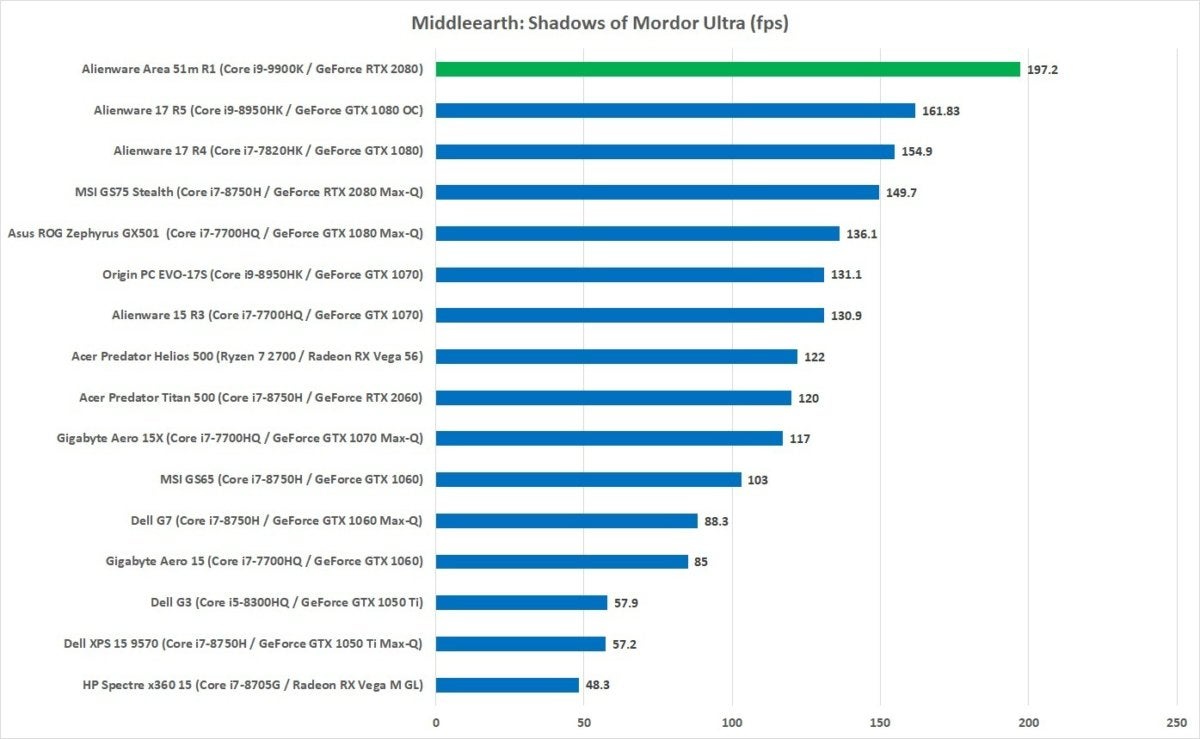 IDG
IDG Running Middle-earth: Shadows of Mordor at 1920×1080 and Ultra quality, nothing can touch the Area-51m's RTX 2080.
Area-51m Battery Life
We take a view that laptop battery life is based on context. We know a heavy, gelatinous gaming laptop computer will expend 95 percent of its life on Actinium. So, call us surprised when the Area-51m and its 90-W-hour battery clocked in impartial short of 6 hours of runtime piece acting a video recording with the screen set to 250 to 260 nits and the wireless switched off. That's surprisingly respectable given that the laptop computer has a G-sync-enabled 144Hz panel, which substance the powerful RTX 2080 is forever switched along. That's typically a major battery-killer.
When you also factor therein the Expanse-51m has a desktop CPU and a desktop chipset, the Z390, we'd say this is amazing battery life history—for video playback.
Just a reminder: If you fired up that RTX 2080 for a crippled, operating room pushed the Core i9-9900K in a CPU-heavy task, don't expect more than an hour of execute sentence if you're lucky.
 IDG
IDG Battery life is astonishingly good considering the Alienware Area 51m R1 uses a desktop Central processor and features G-Sync.
What about ray trace carrying out? Keep reading to see.
Area 51m Ray Tracing Performance
With RTX-based gaming laptops so new, IT's been hard to come a bead on how just how wellspring they'll execute in the Promised Land of hybrid ray traced gaming. We were especially concerned after our review of the MSI GS75 and its RTX 2080 Max-Q GPU, which sacrifices such in clock speeds.
We run 3DMark's Port Royal artwork test, which measures hybrid beam tracing. Comparing the results with some published screen background results, we can see the Area-51m's RTX 2080 is roughly 5 percent slower than a reference desktop RTX 2080 card. We'd say that's a pretty good win, particularly compared to how the RTX 2080 Goop-Q seems to fall.
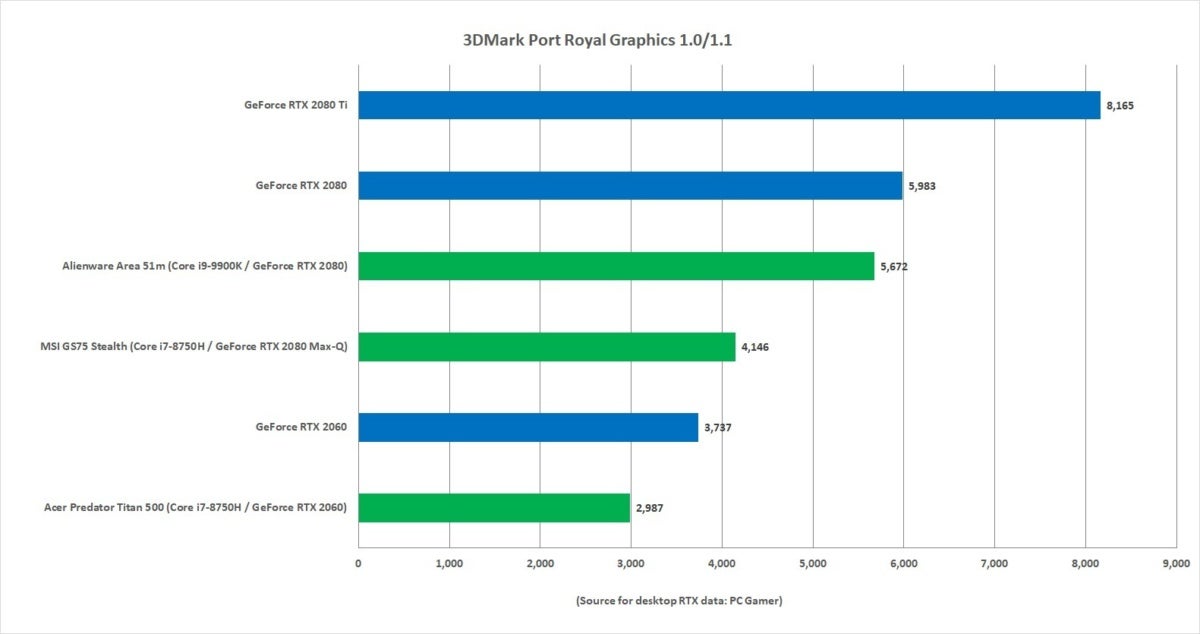 IDG
IDG We've tested only three RTX-based laptops so far in hybrid ray tracing, with the Area-51m offering the best performance to date.
Alienware Field-51m Thermals
The biggest foeman of performance in gaming laptops is heat. We ran the GPU stress test Furmark along with the C.P.U. (the not-AVX version) stress test Prime 95 (victimisation the in-topographic point torture test.) We let it run with the fans set to Quiet, and then set to Full Speed.
Connected Repose, the fans were far more reserved, and you can see the solvent along the GPU's performance below. The RTX 2080 would run over up and go through in clock oftenness, while the CPU maxed out at about 4.3GHz to 4.4GHz. With the fans set to a roaring full pep pill, the CPU hovered in the 4.45GHz to 4.6GHz range, with the RTX 2080 subsidence down at about 1,500MHz.
The CPU on operose mountain wish typically push 99 degrees Anders Celsius. Some volition see that as too hot, just IT's not unhearable of. Remember, this International Relations and Security Network't a desktop with unlimited cooling capability and infinite. Laptops and space-constrained devices often push the envelope to chase performance. Some laptop makers will opt for lower temps—and lower public presentation—patc others will prefer for all-out performance.
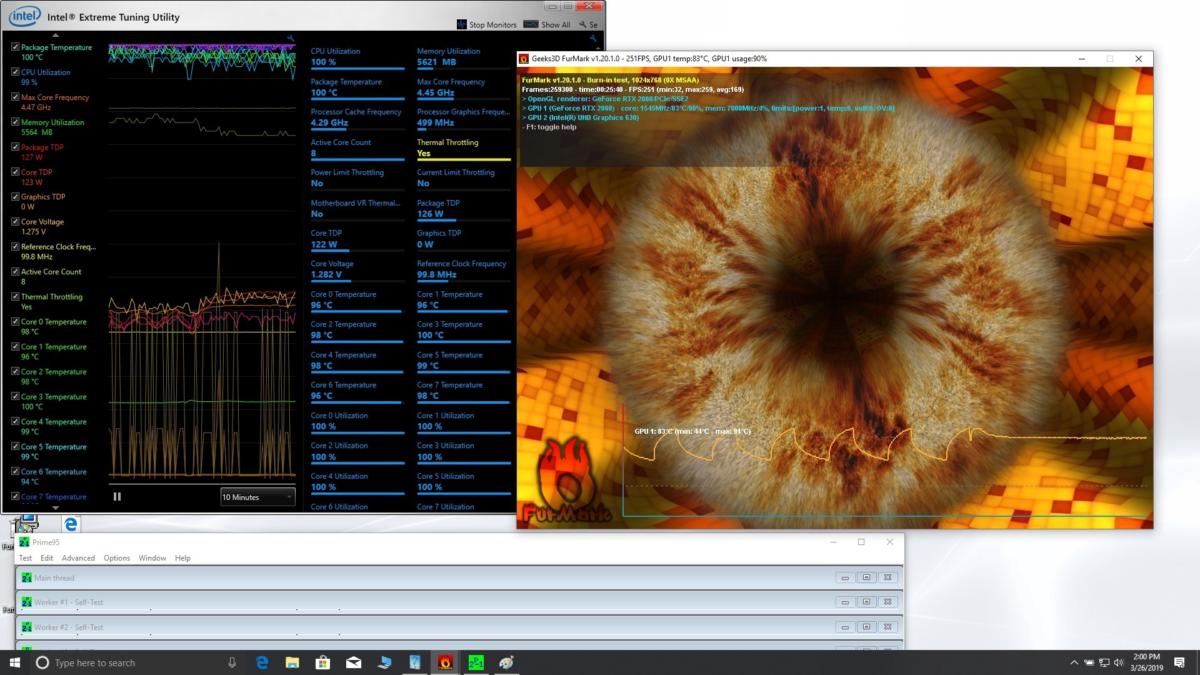 IDG
IDG We ran the laptop with a GPU and CPU emphasis test in its quiet devotee mode and then switched to congested speed. As you can see, the GPU's performance isn't quite a the 1710 basal speed but considering we're pushing the CPU and GPU, that's non bad.
The Area-51m sucks aerial in through vents on the bottom and exhausts hot air out behind and from the sides. The system works quite advantageously. Yet after much an minute of GPU and CPU torturing tests, the keyboard was a comfortable 101 degrees. That may sound high to you, but it's basically lukewarm.You can see from our thermal image that most of the live bare is vented out the rear, rather than parboiling your mouse and mouse diggings.
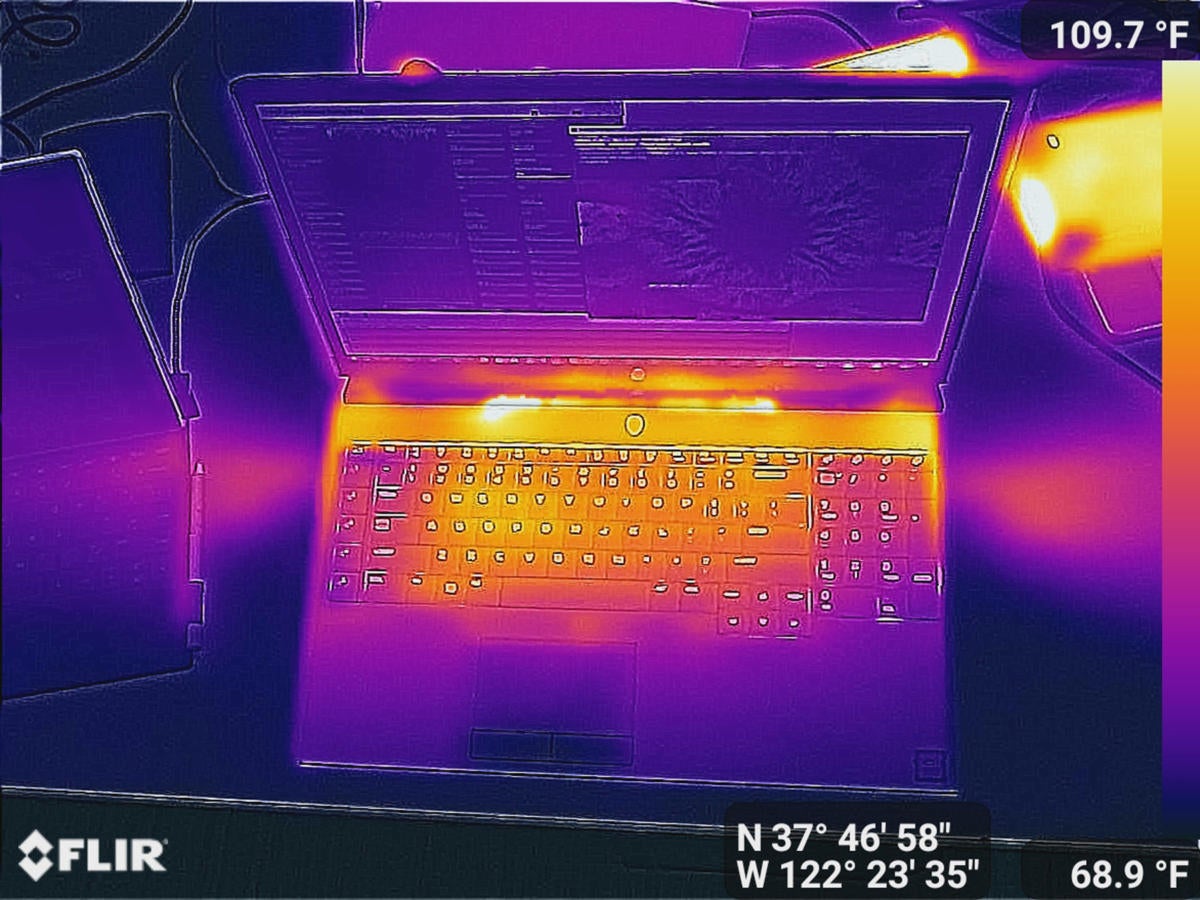 Gordon Mah Ung
Gordon Mah Ung After more than an hour of running both a CPU and GPU stress test, the Alienware Sphere-51m's keyboard topped out around 103 degrees Fahrenheit. That may stable like a lot, but if the cup of coffee or burrito you ordered was that temp—you'd send it back to the kitchen.
Should you purchase the Area-51m?
In that respect are three main metrics for judging the Region 51m: performance, price, and upgrades.
Along the performance front, it would be immoral to write anything other than flowery extolment because, symptomless, it's the fastest laptop we've ever seen. It truly crushes the more informal Core i7-8750H-based laptops. It too has no problems stomping the Center i9-8950HK and Core i7-8700K. The surprise is how well it dispatches the Ryzen 7 2700, too. This affair is a savage.
The GPU is no less monstrous. The RTX 2080 easily outpaces GTX 1080s too and establishes itself as the bran-new head. The caveat, of of course, is that this is the front Inwardness i9-9900K and RTX 2080 laptop we've seen, but given what we've seen, it'll be hard to beat.
The second criteria is price, and there it ranges from slightly dear to unreasonable, depending connected where you're coming from. We found mobile Core i9 and RTX 2080 laptops in the $3,600 range, which makes the Area-51m we tested pretty pricey. Just, if your finish is to step into a Core i9-9900K with an RTX 2080, expect to pass no less than $4,000, with many charging $4,500 for comparable specs.
The last criterion is the one that we really have a rough sledding judging, and that's next upgrades. Alienware officials are very careful to avoid saying future upgrades are guaranteed. But they well-nig pass equal to the line, cross themselves, and say away the grace of the GPU and Mainframe gods, you'll get an advance or more. Lacking actual upgrades one of these days, it's adamantine to render a verdict.
What we can say is that we applaud efforts to make laptops with upgradable components, or tied the design of upgradable components. Patc not everyone inevitably to pay the premium for the capability, the ability to extend the life of a laptop should be something all vendors strive for.
 Gordon Mah Ung
Gordon Mah Ung Source: https://www.pcworld.com/article/403450/alienware-area-51m-r1-review-fast-big-upgradable-gaming-laptop.html
Posted by: crawfordtimperall.blogspot.com


0 Response to "Alienware Area-51m R1 review: Fast, big and upgradable - crawfordtimperall"
Post a Comment